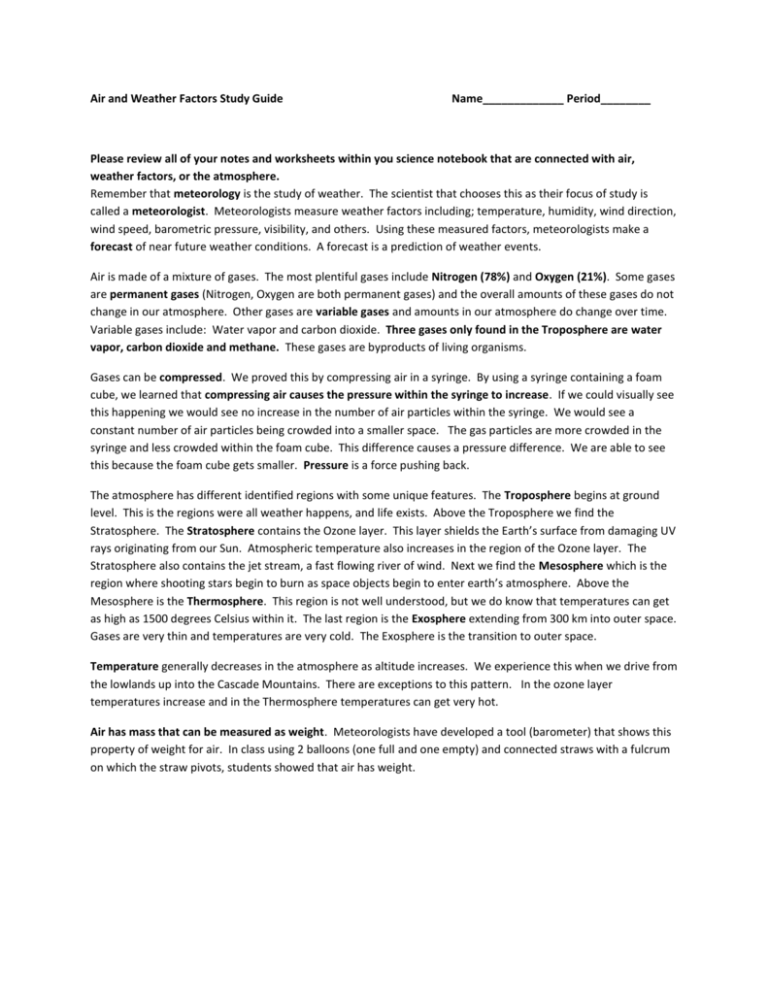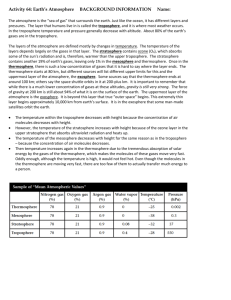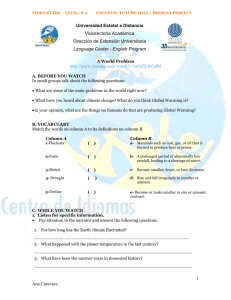Air and Weather Factors Study Guide 2015_3
advertisement

Air and Weather Factors Study Guide Name_____________ Period________ Please review all of your notes and worksheets within you science notebook that are connected with air, weather factors, or the atmosphere. Remember that meteorology is the study of weather. The scientist that chooses this as their focus of study is called a meteorologist. Meteorologists measure weather factors including; temperature, humidity, wind direction, wind speed, barometric pressure, visibility, and others. Using these measured factors, meteorologists make a forecast of near future weather conditions. A forecast is a prediction of weather events. Air is made of a mixture of gases. The most plentiful gases include Nitrogen (78%) and Oxygen (21%). Some gases are permanent gases (Nitrogen, Oxygen are both permanent gases) and the overall amounts of these gases do not change in our atmosphere. Other gases are variable gases and amounts in our atmosphere do change over time. Variable gases include: Water vapor and carbon dioxide. Three gases only found in the Troposphere are water vapor, carbon dioxide and methane. These gases are byproducts of living organisms. Gases can be compressed. We proved this by compressing air in a syringe. By using a syringe containing a foam cube, we learned that compressing air causes the pressure within the syringe to increase. If we could visually see this happening we would see no increase in the number of air particles within the syringe. We would see a constant number of air particles being crowded into a smaller space. The gas particles are more crowded in the syringe and less crowded within the foam cube. This difference causes a pressure difference. We are able to see this because the foam cube gets smaller. Pressure is a force pushing back. The atmosphere has different identified regions with some unique features. The Troposphere begins at ground level. This is the regions were all weather happens, and life exists. Above the Troposphere we find the Stratosphere. The Stratosphere contains the Ozone layer. This layer shields the Earth’s surface from damaging UV rays originating from our Sun. Atmospheric temperature also increases in the region of the Ozone layer. The Stratosphere also contains the jet stream, a fast flowing river of wind. Next we find the Mesosphere which is the region where shooting stars begin to burn as space objects begin to enter earth’s atmosphere. Above the Mesosphere is the Thermosphere. This region is not well understood, but we do know that temperatures can get as high as 1500 degrees Celsius within it. The last region is the Exosphere extending from 300 km into outer space. Gases are very thin and temperatures are very cold. The Exosphere is the transition to outer space. Temperature generally decreases in the atmosphere as altitude increases. We experience this when we drive from the lowlands up into the Cascade Mountains. There are exceptions to this pattern. In the ozone layer temperatures increase and in the Thermosphere temperatures can get very hot. Air has mass that can be measured as weight. Meteorologists have developed a tool (barometer) that shows this property of weight for air. In class using 2 balloons (one full and one empty) and connected straws with a fulcrum on which the straw pivots, students showed that air has weight.







